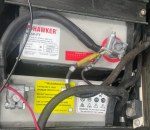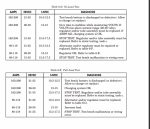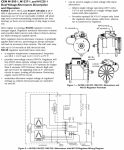blutow
Well-known member
- 357
- 501
- 63
- Location
- Austin, TX
I'm trying to understand the design of the electrical system on my m1123 and trouble shooting a battery balance issue. I have the 200a dual voltage generator. Everything seems to be working OK, but I have a pretty significant battery imbalance. It's not the batteries because I've swapped positions with them and the problem just moves to the other battery.
My "rear" battery is always higher than the front and it looks like my charging system is somehow pushing more amps to that battery (at least for a while after starting the truck). So, I'll have the rear battery reading ~15v and the front reading ~13v. After running for a little bit and as the amps drop (as batteries are topped off), the voltage normalizes a bit, but I'll still be at 14.5v on the rear and 13.5v on the front. 13.5v is not high enough to properly charge and condition the battery.
I'm wondering if this is somehow related to the dual voltage system and maybe the 12v feed is feeding the rear battery. I see that there are some wires going to the positive terminal on the rear battery and I'm not clear what is going on there. Pic below are the wires I'm referring to (yellow heat shrink on one of the wires). I also notice that my 12v output on my voltage regulator is putting out a little over 15v when the truck is started and then eventually settles to down to around 14.4v after it's been running a while. I found the TM that goes through the alternator check and repair, but I can't find anything that provides an overview of the electrical system and what is going on or how it should behave.
PIc below shows the positive terminal on the rear battery with the wires hanging off (yellow heat shrink on one of the wires). I assume this is for a 12v feed, but not clear what it's for. I'm also not clear if it's connected to the 12v output of the generator. My 12v generator output is more than half the output of the 24v output, so it would make sense that it's giving the rear battery more volts if that is a connection to the generator. Maybe a problem with my voltage regulator with the 12v side a bit high? Ideally, I need to be charging both batteries at 14v or higher and the front battery is not doing that with the current behavior. Any thoughts? Is there a TM somewhere that explains how the mixed voltage system works and whether this could affect charging?

My "rear" battery is always higher than the front and it looks like my charging system is somehow pushing more amps to that battery (at least for a while after starting the truck). So, I'll have the rear battery reading ~15v and the front reading ~13v. After running for a little bit and as the amps drop (as batteries are topped off), the voltage normalizes a bit, but I'll still be at 14.5v on the rear and 13.5v on the front. 13.5v is not high enough to properly charge and condition the battery.
I'm wondering if this is somehow related to the dual voltage system and maybe the 12v feed is feeding the rear battery. I see that there are some wires going to the positive terminal on the rear battery and I'm not clear what is going on there. Pic below are the wires I'm referring to (yellow heat shrink on one of the wires). I also notice that my 12v output on my voltage regulator is putting out a little over 15v when the truck is started and then eventually settles to down to around 14.4v after it's been running a while. I found the TM that goes through the alternator check and repair, but I can't find anything that provides an overview of the electrical system and what is going on or how it should behave.
PIc below shows the positive terminal on the rear battery with the wires hanging off (yellow heat shrink on one of the wires). I assume this is for a 12v feed, but not clear what it's for. I'm also not clear if it's connected to the 12v output of the generator. My 12v generator output is more than half the output of the 24v output, so it would make sense that it's giving the rear battery more volts if that is a connection to the generator. Maybe a problem with my voltage regulator with the 12v side a bit high? Ideally, I need to be charging both batteries at 14v or higher and the front battery is not doing that with the current behavior. Any thoughts? Is there a TM somewhere that explains how the mixed voltage system works and whether this could affect charging?







